
ATI revealed its last generation Radeon 5000 graphics family last September, when we got the chance to review the ATI Radeon HD 5870, and what a treat that was.
In a few tests the single-GPU Radeon HD 5870 was able to outgun the mighty GeForce GTX 295, while in most it managed to match or improve upon the Radeon HD 4870 X2. As you are likely aware, both of these products carry dual GPUs, which bring a number of implications, not to mention bigger price tags.
Looking forward we knew Nvidia would have no immediate response to the new Radeons, while on the other hand ATI was not done unleashing its full series of products. Subsequently we looked at two more products that were meant to underperform the flagship HD 5870: the slightly cut down Radeon HD 5850 and the mainstream aimed HD 5770.
From left to right: Radeon HD 5770, HD 5850, HD 5870, and HD 5970.
But as we discussed in our preliminary Radeon 5870 review, on the horizon was also a follow-up to the Radeon HD 4870 X2, code-named "Hemlock XT", which in essence would put together a pair of Radeon HD 5870 GPUs on a single PCB.
Today AMD is officially unveiling the Hemlock as the new ATI Radeon HD 5970, hoping to expand its current dominance in single-GPU performance with the fastest single-slot graphics card on the market -- a title that until today was reserved for Nvidia's dual-GPU GeForce GTX 295.
The Radeon HD 5970 looks to be well suited for the job. The GPUs used in this card use exactly the same configuration found on the Radeon HD 5870, while core and memory frequencies match those of the Radeon HD 5850. This provides the HD 5970 with an unmatched memory bandwidth of 256GB/s.
All this horsepower will come at a hefty price, as AMD expects to charge as much as $600 for it. This is a bit hard to swallow, but all things considered it's about where we expected it to stand among the rest of high-end graphics offerings.

Full exposure: A "naked" Radeon HD 5970 graphics card.
The $400 Radeon HD 5870 is still sold out virtually everywhere due to extreme shortages. The Radeon HD 5850 version still costs $300, meaning that a pair of them would cost the same amount as a single Radeon HD 5970, and we do not expect the performance to be nearly as good. On the other side of the equation, Nvidia's top performer, the GeForce GTX 295 is selling for around $500.
As we see it, only extreme users looking for the best possible gaming experience - or the bragging rights attached to the label - will find the Radeon HD 5970 to make complete sense.
Knowing this is the 5970's intended market, AMD has stamped a big "unlocked" label over the card in our press kit. Perhaps more marketing buzz than actual functionality, the Radeon HD 5970 allows you to jack core and memory frequencies as high as you like -- or at least as high as they will go without compromising stability. This in itself is far from exciting news as there's been software available to do just that for ages.
The most interesting part should come from the ability to adjust voltages and thus increase the card's overclocking room, something we'll be checking in detail next.
Radeon HD 5970: The Card In Detail

Our review sample hung a total of 6cm off the edge of our Asus P6T Deluxe motherboard used for testing.



Cooling the Hemlock XT GPUs is a large aluminum heatsink made up of 36 fins. Measuring 16cm long, 7cm wide, and 2.5cm tall, it is slightly larger than that used in the Radeon HD 5870. Connected to the base of this heatsink is a massive copper plate which helps improve efficiency, while a 75x20mm blower fan draws air in from within the case and pushes it out through the rear of the graphics card.
For the most part this fan operates very quietly, helped by the impressively low 42 watt idle consumption of the Radeon HD 5970. When gaming, the fan will inevitably spin up as the card can consume up to 294 watts under load, but even with the increased thermal stress the 5970 does not scream at intolerable levels.

The heatsink and fan have been enclosed within a custom built housing that conceals the entire graphics card, which is the same design used with the Radeon HD 5870. This setup helps protect the card very well; Nvidia has been using similar enclosures for some time with their most prized graphics cards, such as the GTX 295.

Removing the heatsink exposes the two GPUs, GDDR5 memory chips, and a few other critical components.
With the heatsink off the Radeon HD 5970 looks almost identical to the Radeon HD 4870 X2, though it is noticeably longer.

Key changes involve the new GDDR5 memory, improved power circuitry, and an updated 2.0 PEX bridge from PLX Technologies, used to link the GPUs together. All this hardware is cooled via the large heatsink that covers the majority of the card’s 30cm long PCB.
GDDR5 memory works at an ever more impressive frequency (1.0GHz x 4) on this particular model, which features a total capacity of 2GB. The core configuration of the Radeon HD 5970 doubles everything in the 4870 X2 with 1600 (320x5) SPUs, 80 TAUs (Texture Address Units), and 32 ROPs (Rasterization Operator Units).

AMD’s reference card came equipped with Hynix ICs (H5GQ1H24AFR-T2C parts). These GDDR5 modules are rated for 1.25GHz operation, so we expect to push them beyond the stock 1.0GHz configuration without hassle.

In order to feed the graphics card enough power, a pair of PCI Express power connectors are used (6-pin and 8-pin sockets). This is the same configuration used by previous dual-GPU graphics cards such as the GeForce 9800 GX2 and Radeon HD 4870 X2, so current high-end power supplies should cater for this new graphics card.

The Radeon HD 5970 naturally supports CrossfireX technology, and therefore in the standard position we find a single connector for bridging two cards together.
The only other connectors can be found on the I/O panel. Our sample featured two dual-DVI connectors and a Mini Display Port connection. Just like the Radeon HD 5870, the 5970 can support a maximum resolution of 2560x1600 on not one but rather three monitors.
ATI Radeon™ HD 5970 Graphics Feature Summary
- Dual GPUs with a total of 4.3 billion 40nm transistors
- TeraScale 2 Unified Processing Architecture
- 3200 Stream Processing Units
- 160 Texture Units
- 256 Z/Stencil ROP Units
- 64 Color ROP Units
- GDDR5 memory interface
- PCI Express 2.1 x16 bus interface
- DirectX 11 support
- Shader Model 5.0
- DirectCompute 11
- Programmable hardware tessellation unit
- Accelerated multi-threading
- HDR texture compression
- Order-independent transparency
- OpenGL 3.2 support1
- Image quality enhancement technology
- Up to 24x multi-sample and super-sample anti-aliasing modes
- Adaptive anti-aliasing
- Super AA
- 16x angle independent anisotropic texture filtering
- 128-bit floating point HDR rendering
- ATI Eyefinity multi-display technology2,3
- Three independent display controllers
- Drive three displays simultaneously with independent resolutions, refresh rates, color controls, and video overlays
- Display grouping
- Combine multiple displays to behave like a single large display
- Three independent display controllers
- ATI Stream acceleration technology
- OpenCL 1.0 compliant
- DirectCompute 11
- Double precision floating point processing support
- Accelerated video encoding, transcoding, and upscaling4,5
- Native support for common video encoding instructions
- ATI CrossFireX™ multi-GPU technology6
- Dual card performance scaling
- ATI Avivo™ HD video & display technology7
- UVD 2 dedicated video playback accelerator
- Advanced post-processing and scaling8
- Dynamic contrast enhancement and color correction
- Brighter whites processing (blue stretch)
- Independent video gamma control
- Dynamic video range control
- Support for H.264, VC-1, and MPEG-2
- Dual-stream 1080p playback support9,10
- DXVA 1.0 & 2.0 support
- Integrated dual-link DVI output with HDCP11
- Max resolution: 2560x160012
- Integrated DisplayPort output
- Max resolution: 2560x160012
- Integrated HDMI 1.3 output with Deep Color, xvYCC wide gamut support, and high bit-rate audio
- Max resolution: 1920x120012
- Integrated VGA output
- Max resolution: 2048x153612
- 3D stereoscopic display/glasses support13
- Integrated HD audio controller
- Output protected high bit rate 7.1 channel surround sound over HDMI with no additional cables required
- Supports AC-3, AAC, Dolby TrueHD and DTS Master Audio formats
- ATI PowerPlay™ power management technology7
- Dynamic power management with low power idle state
- Ultra-low power state support for single and multi-board configurations
- Certified drivers for Windows 7, Windows Vista, and Windows XP
Speeds & Feeds
- Engine clock speed: 725 MHz
- Processing power (single precision): 4.64 TeraFLOPS
- Processing power (double precision): 928 GigaFLOPS
- Polygon throughput: 1.45 billion polygons/sec
- Data fetch rate (32-bit): 464 billion fetches/sec
- Texel fill rate (bilinear filtered): 116 Gigatexels/sec
- Pixel fill rate: 46.4 Gigapixels/sec
- Anti-aliased pixel fill rate: 185.6 Gigasamples/sec
- Memory clock speed: 1.0 GHz
- Memory data rate: 4.0 Gbps
- Memory bandwidth: 256.0 GB/sec
- Maximum board power: 294 Watts
- Idle board power: 51 Watts
- Driver support scheduled for release in 2010
- To enable a third display you require one panel with a DisplayPort connector or an active DisplayPort adapter
- ATI Eyefinity technology works with games that support non-standard aspect ratios which is required for panning across three displays
- Requires application support for ATI Stream technology
- Digital rights management restrictions may apply
- ATI CrossFireX™ technology requires an ATI CrossFireX Ready motherboard, an ATI CrossFireX™ Bridge Interconnect (for each additional graphics card) and may require a specialized power supply
- ATI PowerPlay™, ATI Avivo™ and ATI Stream are technology platforms that include a broad set of capabilities offered by certain ATI Radeon™ GPUs. Not all products have all features and full enablement of some capabilities and may require complementary products
- Upscaling subject to available monitor resolution
- Blu-ray or HD DVD drive and HD monitor required to play Blu-ray / HD DVD discs
- Requires Blu-ray movie disc supporting dual 1080p streams
- Playing HDCP content requires additional HDCP ready components, including but not limited to an HDCP ready monitor, Blu-ray or HD DVD disc drive, multimedia application and computer operating system.
- Some custom resolutions require user configuration
- Requires 3D stereo drivers, glasses, and display


0 comments:
Post a Comment